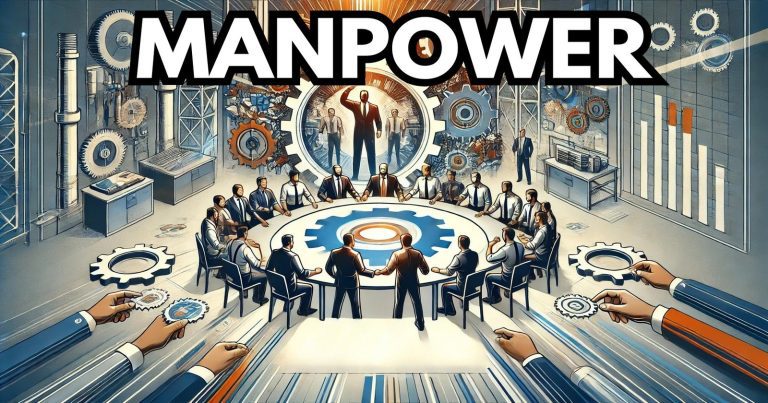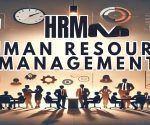Manpower forms one of the most important sources for any organization because it includes the total manpower needed to achieve tasks and progression. We would define manpower as the total aggregate of skilled, unskilled, and professional workers available to work in an organization or even a country. It is part of human resources needed in many sectors to produce planning, its implementation, and ultimately the results achieved.
What is Manpower?
Manpower refers to the sum total human effort required to make an organization work effectively. Manpower thus involves all individuals whose physical as well as mental efforts are offered toward the completion of organizational tasks. Businesses, governments, and industries rely on manpower to make operations run.
It deals with diverse skill areas, from menial labor to white-collar professionals. Therefore, manpower is the backbone support for any organization Proper employment of manpower definitely ensures economic progress, productivity gains, and the quality of the services. Now, the concern of the organization is to find, train, and manage that resource to supply the present needs and future ones.
Define Manpower
The term defined manpower summarises in essence the great essence of an organisation’s human resources. One could say it refers to an agglutination of humans whose efforts bring skill, capability, and innovation for a viable task of supporting sustainability and organizational growth. At all operational and top-management levels, these come as human power.
Manpower is the backbone of most industries since it helps achieve established goals and efficiently execute strategies. Through manpower, the human potential is, therefore highlighted; however, it is actually stressed that manpower is adaptable, innovates, and is also resilient.
Define Manpower Handling
Manpower handling refers to the proper management of human resources in organizations. It involves the strategic allocation of the right type of task, continuous monitoring of performance, resource provision, and motivation, which enhances employees’ contribution at the organizational level. Improved manpower handling increases productivity levels, and job satisfaction, and individual inputs are directly in harmony with those of the organizations. Other Elements of Manpower Management are:-
Distribution
Distribution is the proper allocation of roles and responsibilities. This is what an organization needs to be successful. Managers will assess the skills, qualifications, and experiences that employees possess to distribute them according to the ability to execute specific tasks. This leads to effective execution, reduces errors, and allows employees to work on areas where they could deliver things effectively. Clearer specifications of roles prevent duplication and make sure all organizational functions are covered easily.
Example: A tech company presents coding jobs to professional coders, while at the same time giving client-facing opportunities to those with the right communication skills.
Performance Monitoring
Performance monitoring is required to evaluate the employees. Monitoring will allow an organization to determine whether its employees are doing well, whether they have areas of improvement, and the kind of training needed. Constructive feedback makes the employees work on their performance, and data-driven insights allow managers to determine the optimization of the workforce. Performance monitoring includes the following:
- Performance benchmarking
- Periodic appraisal
- Actionable feedback.
This continuous monitoring will keep the employees always aligned with the organizational goals and remain at their highest productivity levels.
Resource Supply
Employees need appropriate tools, training, and resources to get the work done. An organization needs to invest in the latest technology, infrastructure, and knowledge building to enable its workforce. The training programs help in developing the skills but get the employees prepared to handle changed roles and technologies also.
For instance, if the manufacturing firm equips its personnel with the relevant safety personnel and equipment, then the firm reduces the risk at the workplace and becomes effective.
Resource provision also encompasses mentoring programs, provision of knowledge banks, and training through work experience. Such practices make the employees become effective contributors toward organizational success.
Motivation
Manpower handling is the backbone motivation. A motivated workforce is more dedicated, innovative, and productive. Organizations must have something to encourage an employee to think about his or her contributions at work. Well-designed incentives, recognition programs, and career advancement opportunities build positive work environments. Some examples of motivational strategies are as follows:
- Money related incentives like rewards of bonuses and raising of salaries.
- Non-monetary ways like the “Employee of the Month” award.
- Progressive career paths.
This implies that the motivation of workers results in their value and maintains them loyal to the organization, hence lowering turnover rates and increasing team cohesion.
Manpower Objectives
Manpower involves the optimization of human resources so that organizational success can be attained. The objective is helpful to the organization, which ensures proper alignment of workforce strategy with organizational business goals such that employees undergo growth and feel satisfied.
- Maximization of Productivity: The productivity maximization forms one of the major attempts from the organizations that involve optimization in the use of manpower. This guarantees the right individuals doing the correct jobs with the correct skills. Therefore, this diminishes redundancy while increasing output.
- Business Growth: Manpower can stimulate innovation and competitiveness. An organization structures the manpower to meet the demands based on its long-term business growth objectives besides market change. A strong force is necessary in a dynamic business so that it might survive.
- Satisfaction of Employees: Employee satisfaction also encompasses morale as well as retention. Organizations can create supportive atmospheres and facilitate career development because they place importance on the input of people which makes them highly motivated.
- Aligning Workforce with Organizational Goals: Organizations align manpower policies with business goals. This involves the evaluation of future needs and preparing employees for changing roles so that there can be sustainability and growth.
- Team Collaboration Enhancement: Manpower strategies focus on teamwork, knowledge sharing, and a collaborative workspace that will trigger success in a project or within operations.
- Building of Workplace Culture: Manpower strategy helps in a positive workplace culture through inclusivity, diversity promotion, and practicing fair treatment within the workplace to maintain top-talented employees.
Manpower Requirement
Manpower is the only requirement to run any organization. Due to increasing industries’ complexities, planning as well as its management of human resources is very much needed to support the fulfillment of operational and strategic needs.
- Bridging the Skill Gap: Manpower is needed in organizations to give a fillip to employees in critical positions, which are continuously being upgraded according to the needs of the market. It will make the organizations run smoothly with the elimination of gaps.
- Technological Changes: New technologies require appropriate manpower using the latest tools and procedures. Manpower helps organizations to stay competitive through the bridging of the gap between technology and skill.
- Continuity in Operations: Manpower ensures the continuity of operations, ensures the supply of goods and services, and gives the customer what they require without breaking them.
- Economic Growth: Manpower positively contributes to the economy by raising productivity and innovativeness. A healthy workforce would produce better outputs with quality service that boosts the economy.
- Long-term Sustainability Support: Any organization that invests in manpower development forms a workforce that can easily adapt to difficult times while ensuring sustainability and growth in the long run.
Define Manpower Planning and State Its Need
Manpower planning is the method of workforce analysis by the organization and preparing steps to bridge those. It will help with the correct level of skilled workforce at the appropriate job on time to cater to the needs of current and in the future.
Why Manpower Planning is needed?
- Strategic Workforce Management: Every job will be done by the right person at the right time.
- Cost Effectiveness: Surplus or scarcity of staff rationing that may attract other labor costs are removed.
- Upskilling: Determines skill gaps in the workforce and hence upskills the manpower.
- Risk Aversion: Organizations are afraid of risks resulting from employee turnover and market trends.
- Preparedness for the Future: Manpower planning makes an organization prepared in advance with industry trends and available technologies.
Steps in Manpower Planning
The manpower planning process is a structured process that helps organizations align their workforce strategies with business goals. It involves a systematic approach to ensure optimal workforce management.
1. Demand Forecasting: This step involves predicting the future manpower needs of an organization to align with its goals and objectives.
- Factors Considered: Industry trends, technological advancements, economic conditions, and business expansion plans.
- Purpose: To ensure the organization has the right number and type of employees to meet future demands.
- Methods: Quantitative techniques like trend analysis, workload analysis, or qualitative methods like expert judgment.
2. Supply Analysis: This step assesses the availability of current manpower within the organization and external labor markets.
- Internal Supply: Identifying existing employees’ skills, experience, and potential for promotion or reassignment.
- External Supply: Analyzing labor market trends, availability of talent, and competition for skilled workers.
- Outcome: Determines whether internal resources are sufficient or if external recruitment is necessary.
3. Gap Analysis: This step identifies discrepancies between the forecasted demand and the available supply of manpower.
- Skill Gaps: Areas where the workforce lacks the necessary skills or expertise.
- Staffing Gaps: Shortages in the number of employees required to meet future needs.
- Redundancies: Overstaffed areas where positions may no longer be necessary.
- Purpose: To prioritize hiring, training, or restructuring efforts to bridge the identified gaps.
4. Action Planning: This step involves developing strategies to address gaps identified in the previous step.
- Recruitment Plans: Hiring new employees to fill skill or staffing shortages.
- Training Programs: Upskilling or reskilling existing employees to meet future needs.
- Workforce Optimization: Implementing job rotations, promotions, or reassignments to use manpower more efficiently.
- Contingency Plans: Preparing for unexpected changes like high turnover or shifting business priorities.
Manpower Handling FAQs
What does define manpower mean?
The process of determining the number of people needed in an organization or economy to get things done to achieve its set goals.
Why is manpower planning necessary?
Manpower planning will make sure that there is a suitable workforce in organizations to fulfill their present and future needs, hence bridging any skill gaps that may be required.
What is manpower handling?
Manpower handling is the administration and optimization of labor resources. Roles are given to people and monitored, and adequate support is provided in manpower handling.
Contribution of Manpower to Economic Growth
Manpower increases productivity, innovation, and quality services; therefore, it leads directly to an improvement in economic growth and competitiveness.
Stages in Manpower Planning
Manpower planning involves an evaluation of manpower requirements, estimation of demand, and supply, followed by recruitment, training, and monitoring.


